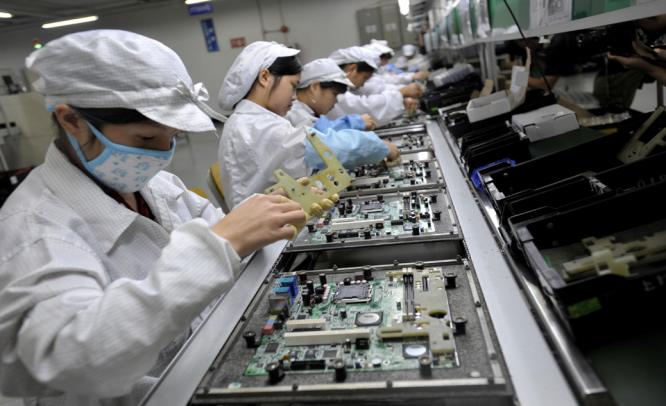Despite rise in export orders, a sluggish domestic demand drags factory operations and prompts economists to predict new policy changes, reports Team IFM
Beijing, March 24: March has turned out to be the worst month for China’s manufacturing sector since last August, data released on Monday by an independent survey reports says, making it also the fifth month at a stretch that factory output contracted.
A key gauge of factory performance – the HSBC Purchasing Managers’ Index or PMI – a measure of the country’s factory output monitored by economic health tracker Markit, fell to 48.1 in March to an eight-month low and goaded analysts to say Beijing could introduce new policy changes.
The results were off what economists polled by financial news and services provider Bloomberg had predicted – a reading of 48.7 – or an actual increase from 48.5 in February.
The index had fallen to a seven-month low to 48.5 in February from 49.5 in January, Markit said. A reading above 50 indicates expansion from the previous month, while a reading below 50 indicates contraction.
The index for March showed that overall new orders slid to 46.9 – a dip for the fourth straight month to reach its lowest point since July 2013 – even as output fell to 47.3, the lowest since September 2012.
Earlier too – government data released , on March 13 – had showed that the speed of China’s industrial output growth slowed beyond expectations in the first two months this year to a five-year low.
It was a finding that prompted Premier Li Keqiang to publicly dwell on “severe challenges” in the year ahead and strengthened earlier independent studies that questioned official factory output claims.
Earlier, independent experts had linked the slowdown to the closure of factories on account of the Lunar New Year holiday. But in March, interestingly, while export orders showed an upswing, the overall volumes of work order placed with factories shrank, reflecting the drag was primarily caused by a subdued domestic demand for goods.
A more accurate picture will emerge on April 1 when Markit releases its final data for March, it said in a statement. Incidentally, the HSBC- Markit PMI covers 420 companies, and factors in more smaller and private companies and accords them greater weightage than the official index, which contains more large and state-owned firms, and which is in the positive territory.
“Weakness is broadly-based with domestic demand softening further,” said Hongbin Qu, Chief economist for China at HSBC, in a statement that accompanied the PMI data that Markit released on Sunday.
“We expect Beijing to launch a series of policy measures to stabilise growth. Likely options include lowering entry barriers for private investment, targeted spending on subways, air-cleaning and public housing, and guiding lending rates lower.”
Challenges Ahead
Qu’s prediction comes on the heels of Premier Li’s March 13 statement warning of “severe challenges” that lay ahead. In a guarded statement at a press conference on the last day of China’s annual parliament, he touched upon a wide range of issues including the Malaysian Airlines mystery.
But he also talked of economic challenges, and boldly announced despite the pitfalls, steps would be taken to check a growth slide. He said Beijing had set a GDP growth of 7.5 per cent in 2014 actual growth as compared 7.7 per cent last year.
“We believe we have the ability, and all the means, to ensure that economic growth will stay within a reasonable range this year,” Li said. “We are not preoccupied with GDP growth.”
Earlier, Li Keqiang had said China could manage with growth of 7.2 per cent, but on Thursday, he refrained for mentioning a minimum level of growth that was acceptable. His only contention was that he would be satisfied with any growth level that created employment.
Li also said financial and fiscal reforms were on the anvil, which once again kindled expectations that bank deposit rates would be liberalises and efforts would be made to streamline debt.
Since last month, with news of contraction in new orders and production trickling in, analysts started predicting Beijing would in no way sit quietly. First Shanghai Securities strategist Linus Yip told Reuters he expected Beijing to act if the economy slowed down any more.
“They cannot proceed with their reform agenda without maintaining a certain level of growth,” Yip was quoted as saying.
Zhiwei Zhang, an economist at a Japanese financial holding company, similarly said he expected Beijing to act.
“We reiterate our view that the recovery in China is not sustainable and that GDP growth will slow to 7.5 per cent year-on-year in the first quarter and 7.1 per cent,” he said.
“We expect the government to loosen monetary policy in the second quarter to support growth.”
After Thursday’s official announcement, Société Générale China economist Wei Yao joined the economists predicting monetary policy changes. “He can’t say, ‘Give up on growth’, and he can’t say, ‘Growth at any cost,’” Wei told The Wall Street Journal.
Early Blimps
Actually, there were already signs that everything was not as rosy as made out to be. After two confidence-boosting announcements in February, news emanated from behind the Great Wall that said February was the worst month for China’s manufacturing sector since last August.
In tune with all-round scepticism, China’s manufacturing contracted in February, the non-official Markit data showed, bolstering belief that contrary to the official stance, the dragon was actually undergoing a slowdown.
“The HSBC Flash China Manufacturing PMI reading for March suggests that China’s growth momentum continued to slow down,” HSBC’s Qu said in the statement.

